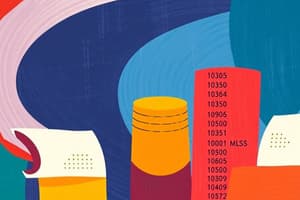Podcast
Questions and Answers
What is the primary difference in balance sheets for manufacturers, merchandisers, and service companies?
What is the primary difference in balance sheets for manufacturers, merchandisers, and service companies?
- Types of inventory (correct)
- Types of liabilities
- Types of revenue
- Types of revenue recognition
Work in process inventory represents items that have been completed and are ready for sale.
Work in process inventory represents items that have been completed and are ready for sale.
False (B)
What term describes the costs associated with converting raw materials into finished products?
What term describes the costs associated with converting raw materials into finished products?
Conversion costs
Products that are completed and available for sale are known as ______ inventory.
Products that are completed and available for sale are known as ______ inventory.
Match the following terms with their definitions:
Match the following terms with their definitions:
What type of cost are beverages for passengers on an airline considered?
What type of cost are beverages for passengers on an airline considered?
Direct labor costs can be traced directly to the finished goods.
Direct labor costs can be traced directly to the finished goods.
What is an example of direct materials cost?
What is an example of direct materials cost?
The wages paid to a mountain bike assembly worker are classified as __________ costs.
The wages paid to a mountain bike assembly worker are classified as __________ costs.
Which of the following statements best defines product costs?
Which of the following statements best defines product costs?
Period costs are typically included in the inventory valuation.
Period costs are typically included in the inventory valuation.
What is the impact of product and period costs on financial statements?
What is the impact of product and period costs on financial statements?
What is the primary purpose of the Schedule of Cost of Goods Manufactured?
What is the primary purpose of the Schedule of Cost of Goods Manufactured?
Cost of Goods Sold for manufacturers is significantly different from cost of goods sold for merchandisers.
Cost of Goods Sold for manufacturers is significantly different from cost of goods sold for merchandisers.
What is one of the learning objectives related to cost of goods sold?
What is one of the learning objectives related to cost of goods sold?
The Schedule of Cost of Goods Manufactured helps link manufacturing costs to __________.
The Schedule of Cost of Goods Manufactured helps link manufacturing costs to __________.
Which of the following activities is part of the flow of manufacturing activities?
Which of the following activities is part of the flow of manufacturing activities?
Understanding the flow of manufacturing costs is irrelevant to financial statements.
Understanding the flow of manufacturing costs is irrelevant to financial statements.
What is the significance of the Schedule of Cost of Goods Manufactured?
What is the significance of the Schedule of Cost of Goods Manufactured?
What formula is used to calculate raw materials inventory turnover?
What formula is used to calculate raw materials inventory turnover?
The average materials inventory is calculated by adding beginning and ending material inventory and then dividing by 2.
The average materials inventory is calculated by adding beginning and ending material inventory and then dividing by 2.
What is the formula for calculating days’ sales in raw materials inventory?
What is the formula for calculating days’ sales in raw materials inventory?
The formula for raw materials inventory turnover is Raw materials used divided by _________.
The formula for raw materials inventory turnover is Raw materials used divided by _________.
What is included in Total Manufacturing Costs?
What is included in Total Manufacturing Costs?
Cost of Goods Manufactured is calculated by adding Beginning Work in Process and Total Manufacturing Costs, then subtracting Ending Work in Process.
Cost of Goods Manufactured is calculated by adding Beginning Work in Process and Total Manufacturing Costs, then subtracting Ending Work in Process.
What is the primary purpose of preparing a schedule of cost of goods manufactured?
What is the primary purpose of preparing a schedule of cost of goods manufactured?
Total Manufacturing Costs equal Direct Materials Used plus Direct Labor and __________.
Total Manufacturing Costs equal Direct Materials Used plus Direct Labor and __________.
Match the following elements with their respective definitions:
Match the following elements with their respective definitions:
Which statement correctly reflects how Ending Work in Process affects Cost of Goods Manufactured?
Which statement correctly reflects how Ending Work in Process affects Cost of Goods Manufactured?
Direct Labor costs should not be included when calculating Total Manufacturing Costs.
Direct Labor costs should not be included when calculating Total Manufacturing Costs.
Explain how Cost of Goods Manufactured links to financial statements.
Explain how Cost of Goods Manufactured links to financial statements.
What is a primary focus of customer orientation in managerial accounting?
What is a primary focus of customer orientation in managerial accounting?
Total Quality Management emphasizes low standards and minimal employee input.
Total Quality Management emphasizes low standards and minimal employee input.
What does Just-In-Time (JIT) manufacturing aim to minimize?
What does Just-In-Time (JIT) manufacturing aim to minimize?
In lean practices, businesses focus on eliminating ______ in their activities.
In lean practices, businesses focus on eliminating ______ in their activities.
Match the following managerial accounting trends with their descriptions:
Match the following managerial accounting trends with their descriptions:
Which of the following is NOT a trend in managerial accounting?
Which of the following is NOT a trend in managerial accounting?
A key aspect of lean practices is to consistently focus on waste in business activities.
A key aspect of lean practices is to consistently focus on waste in business activities.
What is the significance of quality awards in Total Quality Management?
What is the significance of quality awards in Total Quality Management?
Flashcards
Product Costs
Product Costs
Costs that are directly related to the production of goods, such as raw materials and labor.
Period Costs
Period Costs
Costs that are not directly related to the production of goods but are incurred in the period in which they are incurred, such as selling, administrative, and marketing expenses.
Direct Materials
Direct Materials
The cost of materials that can be directly traced to a specific product, such as the steel used in a bike frame.
Direct Labor
Direct Labor
Signup and view all the flashcards
Period Costs, Example
Period Costs, Example
Signup and view all the flashcards
Variable Costs
Variable Costs
Signup and view all the flashcards
Fixed Costs
Fixed Costs
Signup and view all the flashcards
Cost Concepts in Service Companies
Cost Concepts in Service Companies
Signup and view all the flashcards
Conversion Costs
Conversion Costs
Signup and view all the flashcards
Work in Process Inventory
Work in Process Inventory
Signup and view all the flashcards
Finished Goods Inventory
Finished Goods Inventory
Signup and view all the flashcards
Cost of Goods Sold (COGS)
Cost of Goods Sold (COGS)
Signup and view all the flashcards
Cost of Goods Sold Calculation
Cost of Goods Sold Calculation
Signup and view all the flashcards
COGS for Manufacturers vs. Merchandisers
COGS for Manufacturers vs. Merchandisers
Signup and view all the flashcards
Flow of Manufacturing Activities
Flow of Manufacturing Activities
Signup and view all the flashcards
Schedule of Cost of Goods Manufactured (COGM)
Schedule of Cost of Goods Manufactured (COGM)
Signup and view all the flashcards
Manufacturing Overhead
Manufacturing Overhead
Signup and view all the flashcards
Total Manufacturing Costs
Total Manufacturing Costs
Signup and view all the flashcards
Cost of Goods Manufactured
Cost of Goods Manufactured
Signup and view all the flashcards
Manufacturing Statement
Manufacturing Statement
Signup and view all the flashcards
Direct labor cost
Direct labor cost
Signup and view all the flashcards
Ending Work in Process
Ending Work in Process
Signup and view all the flashcards
Beginning Work in Process
Beginning Work in Process
Signup and view all the flashcards
Direct Materials Used
Direct Materials Used
Signup and view all the flashcards
Factory Overhead
Factory Overhead
Signup and view all the flashcards
Raw Materials Inventory Turnover
Raw Materials Inventory Turnover
Signup and view all the flashcards
Days' Sales in Raw Materials Inventory
Days' Sales in Raw Materials Inventory
Signup and view all the flashcards
Average Raw Materials Inventory
Average Raw Materials Inventory
Signup and view all the flashcards
Raw Materials Used
Raw Materials Used
Signup and view all the flashcards
Ending Raw Materials Inventory
Ending Raw Materials Inventory
Signup and view all the flashcards
Customer Orientation
Customer Orientation
Signup and view all the flashcards
Total Quality Management (TQM)
Total Quality Management (TQM)
Signup and view all the flashcards
Just-In-Time (JIT) Manufacturing
Just-In-Time (JIT) Manufacturing
Signup and view all the flashcards
Global Economy
Global Economy
Signup and view all the flashcards
Service Economy
Service Economy
Signup and view all the flashcards
Value Chain
Value Chain
Signup and view all the flashcards
Lean Practices
Lean Practices
Signup and view all the flashcards
E-Commerce
E-Commerce
Signup and view all the flashcards
Study Notes
Chapter 14: Planning and Management Control Systems
- The chapter focuses on managerial accounting concepts and principles.
- Managerial accounting provides financial and nonfinancial information to managers and other decision-makers within an organization.
- It helps managers make planning and control decisions.
- Managerial accounting information is used in various career paths, including marketing, management, entrepreneurship, and non-business roles.
- Managerial accounting's purpose involves planning, monitoring, and controlling business activities.
- The purpose is to develop new products, expand markets, and build new facilities.
- It also involves evaluating performance, finding areas where costs are too high, assessing profitability of services, and evaluating customer satisfaction.
- Managerial accounting differs from financial accounting.
- Financial accounting reports are primarily for external users, like investors and creditors, and are structured by GAAP principles.
- Information in managerial accounting may be generated quickly without extensive auditing.
- It often focuses on future projections and historical data alongside financial information.
- Financial data are monetary but some non-monetary data may also be considered.
- Fraud affects all businesses and can cost significant revenue losses.
- Internal controls are policies and procedures used to guarantee reliable accounting, protect assets, and support company policies.
- The Institute of Management Accountants provides an ethical code of conduct for accountants.
- Learning objectives cover the principles of managerial accounting, cost classifications (fixed vs. variable, direct vs. indirect), and the impact of product and period costs on financial statements.
- Different balance sheets and income statements are used for manufacturing, merchandising, and service companies, especially concerning inventory.
- Cost of goods sold calculations differ for merchandising and manufacturing businesses.
- Manufacturing activities encompass acquiring raw materials, production processes, and sales.
- A schedule of cost of goods manufactured summarizes costs in a company's manufacturing process, involving direct materials, direct labor, and factory overhead.
- Raw materials are expenditures directly traced to finished goods.
- Direct labor involves wages of assembly or production workers.
- Factory overhead encompasses indirect labor and materials.
- Prime cost is the sum of direct materials and direct labor, while conversion cost combines direct labor and factory overhead.
- Nonmanufacturing costs include selling and administrative expenses.
- Learning objectives also cover analyzing raw materials inventory using turnover and days of sales in raw materials and calculation methods.
- Trends in managerial accounting include customer orientation, lean practices, global economy, e-commerce, service economy, value chains, total quality management, and corporate social responsibility.
Studying That Suits You
Use AI to generate personalized quizzes and flashcards to suit your learning preferences.




